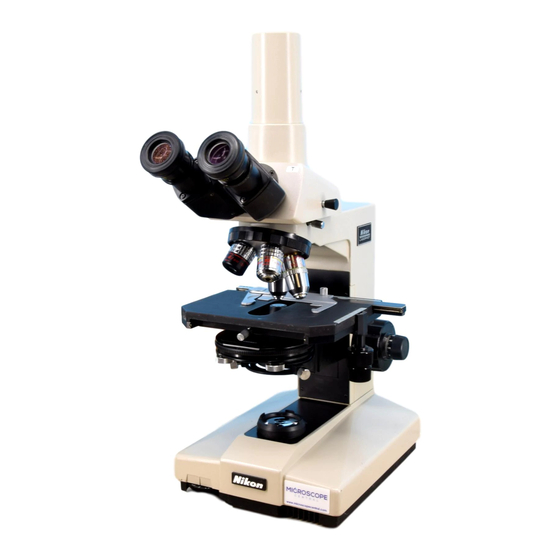Nikon Labophot Manual de instrucciones - Página 11
Navegue en línea o descargue pdf Manual de instrucciones para Microscopio Nikon Labophot. Nikon Labophot 28 páginas. Y-r stand biological microscope

The graduation on the Abbe condenser indicates
the diameters in mm of the aperture diaphragm
opening of condenser ..
After removing the eyepiece from the eyepiece
tube, adjust the size of the diaphragm, observ-
ing the image of the diaphragm which is visible
on the bright circle of exit pupil of objective
inside.
It is recommended to take note of the diameter
of the diaphragm opening for each objective
power, whereby the best image is obtained.
The
Swing-out
Achromat
and
Achromat/
aplanat condensers, however,
have
a graduation
indicating the numerical apertures (N.A.l. and
not the diameters of diaphragm opening.
Manipulation of these condensers is the same as
that of the Abbe condenser. Stopping down the
aperture diaphragm too far will deteriorate the
image quality of microscope due to diffraction
of light. Therefore, it is not recommended to
stop down the aperture to a size smaller than
60% of the N.A. of the objective in use except
when observing almost transparent specimen.
6) Use of field diaphragm
The field diaphragm is used for determining the
illuminated
area on the specimen surface in
relation to the field of view of the microscope.
Generally, it is stopped down to such an extent
that the circumference of the illuminated area
circumscribes or inscribes that of the eyepiece
field of view. If the former be larger than the
latter, extraneous light will enter the field of
view, causing flare in the image and lowering
the contrast.
Therefore,
especially in photo-
micrography, the proper adjustment of the field
diaphragm is very important.
Generally, good
results will be achieved when the diaphragm is
stopped down to such an extent that the dia-
meter of illuminated area is slightly larger than
the diagonal of film format.
7) Focusing
The relation between the direction of rotation
of the focus knobs and that of vertical move-
ment of the stage is as indicated in Fig. 14.
One rotation of the fine focus knob moves the
stage O.2mm.
The graduation on this focus knob is divided
into
2J.Lm.
One rotation of the coarse focus knob moves
11
the stage 4.7mm.
The range of coarse and fine motion is within
30mm;
2mm up and 28mm down from the
standard position.
Tightness of the coarse-fine focus knob having
been properly
adjusted by the manufacturer,
it should never be readjusted in this model
microscope
by turning
the one knob while
holding the other.
J
